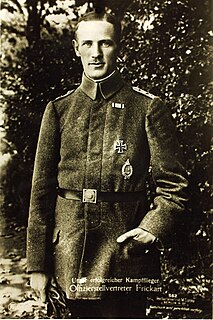| Heinrich Henkel | |
|---|---|
| Born | 11 May 1896 Hamburg, German Empire |
| Died | Unknown |
| Allegiance | Germany |
| Service/ | Aviation |
| Rank | Leutnant |
| Unit | Jasta 37 |
| Awards | Iron Cross |
Leutnant Heinrich Henkel (born 11 May 1896, date of death unknown) was a World War I flying ace credited with eight aerial victories. [1]

A flying ace, fighter ace or air ace is a military aviator credited with shooting down several enemy aircraft during aerial combat. The actual number of aerial victories required to officially qualify as an ace has varied, but is usually considered to be five or more.
Heinrich Henkel was born in Hamburg, the German Empire on 11 May 1896. [2]

Hamburg is the second-largest city in Germany with a population of over 1.8 million.

The German Empire, also known as Imperial Germany, was the German nation state that existed from the unification of Germany in 1871 until the abdication of Kaiser Wilhelm II in 1918.
On 1 September 1914, Henkel volunteered for military service in Reserve Fusilier Artillery Regiment Nr. 3. He went into battle with them at Nancy, France, at Antwerp, and at Ypres. On 1 July 1915, he was transferred to the infantry. He was wounded in action on 25 September 1916. He was subsequently promoted to the officer's ranks as a Leutnant in December 1916. He volunteered for aviation duty and began training at Fliegerersatz-Abteilung (Replacement Detachment) 1 in February 1917. [2]

Antwerp is a city in Belgium, and is the capital of Antwerp province in Flanders. With a population of 520,504, it is the most populous city proper in Belgium, and with 1,200,000 the second largest metropolitan region after Brussels.

Ypres is a Belgian municipality in the province of West Flanders. Though the Dutch Ieper is the official name, the city's French name Ypres is most commonly used in English. The municipality comprises the city of Ypres and the villages of Boezinge, Brielen, Dikkebus, Elverdinge, Hollebeke, Sint-Jan, Vlamertinge, Voormezele, Zillebeke, and Zuidschote. Together, they are home to about 34,900 inhabitants.
Wounded in action (WIA) describes combatants who have been wounded while fighting in a combat zone during wartime, but have not been killed. Typically it implies that they are temporarily or permanently incapable of bearing arms or continuing to fight.
Henkel would also undergo fighter pilot's training at Valenciennes, France before joining Jagdstaffel 37 in May 1918. He scored his first aerial victory on 9 July, and had scored seven more by 31 October 1918. Three of his eight victories were shot-down observation balloons, making him a "balloon buster". Heinrich Henkel survived the war, having won the Iron Cross for his gallantry, but faded into obscurity. [2]

A fighter pilot is a military aviator trained to engage in air-to-air combat while in the cockpit of a fighter aircraft. Fighter pilots undergo specialized training in aerial warfare and dogfighting. A fighter pilot with at least five air-to-air kills becomes known as an ace.

Valenciennes is a commune in the Nord department in northern France.
Royal Prussian Jagdstaffel 37, commonly abbreviated to Jasta 37, was a "hunting group" of the Luftstreitkräfte, the air arm of the Imperial German Army during World War I. The unit would score over 70 aerial victories during the war, including 13 observation balloons downed. The squadron's victories came at the expense of seven killed in action, two killed in flying accidents, three wounded in action, and three taken prisoner of war.




